Metamaterials-Enabled Sensing for Human-Machine Interfacing
Abstract
1. Introduction
2. Metamaterials-Based Sensing Principles
3. Metamaterials-Enabled Sensing
3.1. Optical Sensing
3.2. Thermal Sensing
3.3. Acoustic Sensing
3.4. Mechanical Sensing
4. Enabled HMI Applications
4.1. HMI Based on Optical/Microwave Sensing
4.2. HMI Based on Thermal Sensing
4.3. HMI Based on Acoustic Sensing
4.4. HMI Based on Mechanical Sensing
5. Conclusions and Perspectives
- Flexible metamaterials for sensing. Most sensing metamaterials or metasurfaces are fabricated on rigid surfaces like the metal/insulator/metal resonator for the easy manipulation of the LSPR effect. However, rigid surfaces are usually not welcome for wearable HMI applications [1,2]. Developing the metamaterial and metasurfaces on flexible and soft substrates are significantly demanded but far from well-developed yet [119,130]. More effort is needed for exploring proper flexible materials and structures for future applications.
- Integration of detecting and sensing systems. Most metamaterials can sense the ambient by the modulated light-matter interactions on the surfaces, but these interactions are detected by external complicated systems [63,66,68,139]. Although the sensitivity is improved by the metamaterials, the complicated detecting systems may disable the wearable HMI applications. Further exploring the integration of the detecting and sensing systems is thus important for promoting the metamaterials-based sensing for HMI applications.
- Metamaterials-enabled multimodal HMI. For HMI applications, many new technologies emerge in recent decades like VR, AR, MR, IoT, and so on [140,141]. In these technologies, more accurate sensors are significantly needed, but metamaterials-based sensors have not been involved in these HMI scenarios. Combining these new types of HMI with metamaterials is quite interesting and worth of exploring in the future.
Author Contributions
Funding
Institutional Review Board Statement
Informed Consent Statement
Data Availability Statement
Conflicts of Interest
References
- Wang, J.; Lin, M.-F.; Park, S.; Lee, P.S. Deformable conductors for human-machine interface. Mater. Today 2018, 21, 508–526. [Google Scholar] [CrossRef]
- Zhong, J.; Ma, Y.; Song, Y.; Zhong, Q.; Chu, Y.; Karakurt, I.; Bogy, D.B.; Lin, L. A Flexible Piezoelectret Actuator/Sensor Patch for Mechanical Human-Machine Interfaces. ACS Nano 2019, 13, 7107–7116. [Google Scholar] [CrossRef] [PubMed]
- Zhang, Q.; Liu, X.; Duan, L.; Gao, G. Nucleotide-driven skin-attachable hydrogels toward visual human-machine interfaces. J. Mater. Chem. A 2020, 8, 4515–4523. [Google Scholar] [CrossRef]
- Zhang, L.; He, J.; Liao, Y.; Zeng, X.; Qiu, N.; Liang, Y.; Xiao, P.; Chen, T. A self-protective, reproducible textile sensor with high performance towards human-machine interactions. J. Mater. Chem. A 2019, 7, 26631–26640. [Google Scholar] [CrossRef]
- Liao, X.; Song, W.; Zhang, X.; Huang, H.; Wang, Y.; Zheng, Y. Directly printed wearable electronic sensing textiles towards human-machine interfaces. J. Mater. Chem. C 2018, 6, 12841–12848. [Google Scholar] [CrossRef]
- Dong, W.; Wang, Y.; Zhou, Y.; Bai, Y.; Ju, Z.; Guo, J.; Gu, G.; Bai, K.; Ouyang, G.; Chen, S.; et al. Soft human-machine interfaces: Design, sensing and stimulation. Int. J. Intell. Robot. Appl. 2018, 2, 313–338. [Google Scholar] [CrossRef]
- Chang, H.; Kim, S.; Jin, S.; Lee, S.-W.; Yang, G.-T.; Lee, K.-Y.; Yi, H. Ultrasensitive and Highly Stable Resistive Pressure Sensors with Biomaterial-Incorporated Interfacial Layers for Wearable Health-Monitoring and Human-Machine Interfaces. ACS Appl. Mater. Interfaces 2018, 10, 1067–1076. [Google Scholar] [CrossRef]
- Cao, R.; Pu, X.; Du, X.; Yang, W.; Wang, J.; Guo, H.; Zhao, S.; Yuan, Z.; Zhang, C.; Li, C.; et al. Screen-Printed Washable Electronic Textiles as Self-Powered Touch/Gesture Tribo-Sensors for Intelligent Human-Machine Interaction. ACS Nano 2018, 12, 5190–5196. [Google Scholar] [CrossRef]
- Jiang, T.; He, Q.; Peng, Z.-K. Proposal for the Realization of a Single-Detector Acoustic Camera Using a Space-Coiling Anisotropic Metamaterial. Phys. Rev. Appl. 2019, 11. [Google Scholar] [CrossRef]
- Ma, C.; Gao, S.; Cheng, Y.; Liu, X. Acoustic metamaterial antennas for combined highly directive-sensitive detection. Appl. Phys. Lett. 2019, 115. [Google Scholar] [CrossRef]
- Vasilantonakis, N.; Wurtz, G.A.; Podolskiy, V.A.; Zayats, A.V. Refractive index sensing with hyperbolic metamaterials: Strategies for biosensing and nonlinearity enhancement. Opt. Express 2015, 23, 14329–14343. [Google Scholar] [CrossRef]
- Semouchkina, E.; Duan, R.; Semouchkin, G.; Pandey, R. Sensing based on Fano-type resonance response of all-dielectric metamaterials. Sensors 2015, 15, 9344–9359. [Google Scholar] [CrossRef]
- Xu, X.; Peng, B.; Li, D.; Zhang, J.; Wong, L.M.; Zhang, Q.; Wang, S.; Xiong, Q. Flexible visible-infrared metamaterials and their applications in highly sensitive chemical and biological sensing. Nano Lett. 2011, 11, 3232–3238. [Google Scholar] [CrossRef]
- Gu, Y.; Li, Q.; Xiao, J.; Wu, K.; Wang, G.P. Plasmonic metamaterials for ultrasensitive refractive index sensing at near infrared. J. Appl. Phys. 2011, 109. [Google Scholar] [CrossRef]
- Gong, S.; Xiao, B.; Xiao, L.; Tong, S.; Xiao, S.; Wang, X. Hybridization-induced dual-band tunable graphene metamaterials for sensing. Opt. Mater. Express 2018, 9, 35–43. [Google Scholar] [CrossRef]
- Ding, W.; Wang, A.C.; Wu, C.; Guo, H.; Wang, Z.L. Human-Machine Interfacing Enabled by Triboelectric Nanogenerators and Tribotronics. Adv. Mater. Technol. 2019, 4. [Google Scholar] [CrossRef]
- Zhou, Z.; Li, Y.; Cheng, J.; Chen, S.; Hu, R.; Yan, X.; Liao, X.; Xu, C.; Yu, J.; Li, L. Supersensitive all-fabric pressure sensors using printed textile electrode arrays for human motion monitoring and human-machine interaction. J. Mater. Chem. C 2018, 6, 13120–13127. [Google Scholar] [CrossRef]
- Zhou, Y.; Wang, Y.; Liu, R.; Xiao, L.; Zhang, Q.; Huang, Y. Multichannel noninvasive human-machine interface via stretchable mu m thick sEMG patches for robot manipulation. J. Micromechanics Microengineering 2018, 28, 014005. [Google Scholar] [CrossRef]
- Young, S.N.; Peschel, J.M. Review of Human-Machine Interfaces for Small Unmanned Systems with Robotic Manipulators. IEEE Trans. Hum. Mach. Syst. 2020, 50, 131–143. [Google Scholar] [CrossRef]
- Young, K.L.; Koppel, S.; Charlton, J.L. Toward best practice in Human Machine Interface design for older drivers: A review of current design guidelines. Accid. Anal. Prev. 2017, 106, 460–467. [Google Scholar] [CrossRef]
- Xu, Z.; Liu, A.; Yue, X.; Zhang, Y.; Wang, R.; Huang, J.; Fang, S.-H. Combining Proximity Estimation with Visible Symbol Assignment to Simplify Line-of-Sight Connections in Mobile Industrial Human-Machine Interaction. IEEE Access 2019, 7, 133559–133571. [Google Scholar] [CrossRef]
- Wu, Y.; Karakurt, I.; Beker, L.; Kubota, Y.; Xu, R.; Ho, K.Y.; Zhao, S.; Zhong, J.; Zhang, M.; Wang, X.; et al. Piezoresistive stretchable strain sensors with human machine interface demonstrations. Sens. Actuators A Phys. 2018, 279, 46–52. [Google Scholar] [CrossRef]
- Wu, P.; Xiao, A.; Zhao, Y.; Chen, F.; Ke, M.; Zhang, Q.; Zhang, J.; Shi, X.; He, X.; Chen, Y. An implantable and versatile piezoresistive sensor for the monitoring of human-machine interface interactions and the dynamical process of nerve repair. Nanoscale 2019, 11, 21103–21118. [Google Scholar] [CrossRef]
- Tsai, Y.-J.; Wang, C.-M.; Chang, T.-S.; Sutradhar, S.; Chang, C.-W.; Chen, C.-Y.; Hsieh, C.-H.; Liao, W.-S. Multilayered Ag NP-PEDOT-Paper Composite Device for Human-Machine Interfacing. ACS Appl. Mater. Interfaces 2019, 11, 10380–10388. [Google Scholar] [CrossRef]
- Xu, L.; Chen, H. Conformal transformation optics. Nat. Photonics 2014, 9, 15–23. [Google Scholar] [CrossRef]
- Sheng, C.; Liu, H.; Wang, Y.; Zhu, S.N.; Genov, D.A. Trapping light by mimicking gravitational lensing. Nat. Photonics 2013, 7, 902–906. [Google Scholar] [CrossRef]
- Kadic, M.; Buckmann, T.; Schittny, R.; Wegener, M. Metamaterials beyond electromagnetism. Rep. Prog. Phys. 2013, 76, 126501. [Google Scholar] [CrossRef]
- Zhang, X.; Liu, Z. Negative refraction of acoustic waves in two-dimensional phononic crystals. Appl. Phys. Lett. 2004, 85, 341–343. [Google Scholar] [CrossRef]
- Vemuri, K.P.; Bandaru, P.R. Anomalous refraction of heat flux in thermal metamaterials. Appl. Phys. Lett. 2014, 104, 83901. [Google Scholar] [CrossRef]
- Matlack, K.H.; Serra-Garcia, M.; Palermo, A.; Huber, S.D.; Daraio, C. Designing perturbative metamaterials from discrete models. Nat. Mater. 2018, 17, 323–328. [Google Scholar] [CrossRef]
- Liu, S.; Cui, T.J.; Xu, Q.; Bao, D.; Du, L.; Wan, X.; Tang, W.X.; Ouyang, C.; Zhou, X.Y.; Yuan, H.; et al. Anisotropic coding metamaterials and their powerful manipulation of differently polarized terahertz waves. Light Sci. Appl. 2016, 5, e16076. [Google Scholar] [CrossRef] [PubMed]
- Perinchery, S.M.; Haridas, A.; Shinde, A.; Buchnev, O.; Murukeshan, V.M. Breaking diffraction limit of far-field imaging via structured illumination Bessel beam microscope (SIBM). Opt. Express 2019, 27, 6068–6082. [Google Scholar] [CrossRef] [PubMed]
- Jiang, Z.H.; Sieber, P.E.; Kang, L.; Werner, D.H. Restoring Intrinsic Properties of Electromagnetic Radiators Using Ultralightweight Integrated Metasurface Cloaks. Adv. Funct. Mater. 2015, 25, 4708–4716. [Google Scholar] [CrossRef]
- Hu, R.; Xie, B.; Hu, J.; Chen, Q.; Luo, X. Carpet thermal cloak realization based on the refraction law of heat flux. EPL Europhys. Lett. 2015, 111, 54003. [Google Scholar] [CrossRef]
- Zhang, S.; Xia, C.; Fang, N. Broadband acoustic cloak for ultrasound waves. Phys. Rev. Lett. 2011, 106, 024301. [Google Scholar] [CrossRef]
- Smolyaninov, I.I.; Davis, C.C. Magnifying superlenses and other applications of plasmonic metamaterials in microscopy and sensing. Chemphyschem 2009, 10, 625–628. [Google Scholar] [CrossRef]
- Zheludev, N.I.; Kivshar, Y.S. From metamaterials to metadevices. Nat. Mater. 2012, 11, 917–924. [Google Scholar] [CrossRef]
- Valentine, J.; Zhang, S.; Zentgraf, T.; Ulin-Avila, E.; Genov, D.A.; Bartal, G.; Zhang, X. Three-dimensional optical metamaterial with a negative refractive index. Nature 2008, 455, 376–379. [Google Scholar] [CrossRef]
- Zhang, X.; Forrest, S.R. Theory of the perfect lens. Phys. Rev. B 2011, 84, 045427. [Google Scholar] [CrossRef]
- Hu, R.; Huang, S.; Wang, M.; Zhou, L.; Peng, X.; Luo, X. Binary thermal encoding by energy shielding and harvesting units. Phys. Rev. Appl. 2018, 10, 054032. [Google Scholar] [CrossRef]
- Hu, R.; Zhou, S.; Li, Y.; Lei, D.-Y.; Luo, X.; Qiu, C.-W. Illusion thermotics. Adv. Mater. 2018, 30, e1707237. [Google Scholar] [CrossRef] [PubMed]
- Zhou, S.; Hu, R.; Luo, X. Thermal illusion with twinborn-like heat signatures. Int. J. Heat Mass Transf. 2018, 127, 607–613. [Google Scholar] [CrossRef]
- Hu, R.; Huang, S.; Wang, M.; Luo, X.; Shiomi, J.; Qiu, C.W. Encrypted thermal printing with regionalization transformation. Adv. Mater. 2019, 31, e1807849. [Google Scholar] [CrossRef] [PubMed]
- Liu, Y.; Cheng, Y.; Hu, R.; Luo, X. Nanoscale thermal cloaking by in-situ annealing silicon membrane. Phys. Lett. A 2019, 383, 2296–2301. [Google Scholar] [CrossRef]
- Wang, M.; Huang, S.; Hu, R.; Luo, X. Analysis of elliptical thermal cloak based on entropy generation and entransy dissipation approach. Chin. Phys. B 2019, 28. [Google Scholar] [CrossRef]
- Zhou, L.; Huang, S.; Wang, M.; Hu, R.; Luo, X. While rotating while cloaking. Phys. Lett. A 2019, 383, 759–763. [Google Scholar] [CrossRef]
- Xinjing, H.; Yutian, Y.; Jinyu, M.; Jian, L.; Xiaobo, R. An Acoustic Metamaterial-Based Sensor Capable of Multiband Filtering and Amplification. IEEE Sens. J. 2020, 20, 4413–4419. [Google Scholar] [CrossRef]
- Fan, K.; Padilla, W.J. Dynamic electromagnetic metamaterials. Mater. Today 2015, 18, 39–50. [Google Scholar] [CrossRef]
- Han, T.; Ye, H.; Luo, Y.; Yeo, S.P.; Teng, J.; Zhang, S.; Qiu, C.W. Manipulating DC currents with bilayer bulk natural materials. Adv. Mater. 2014, 26, 3478–3483. [Google Scholar] [CrossRef]
- Zhang, S.; Genov, D.A.; Sun, C.; Zhang, X. Cloaking of matter waves. Phys. Rev. Lett. 2008, 100, 123002. [Google Scholar] [CrossRef]
- Bonfanti, S.; Guerra, R.; Font-Clos, F.; Rayneau-Kirkhope, D.; Zapperi, S. Automatic design of mechanical metamaterial actuators. Nat. Commun. 2020, 11. [Google Scholar] [CrossRef] [PubMed]
- Lee, Y.; Kim, S.J.; Park, H.; Lee, B. Metamaterials and Metasurfaces for Sensor Applications. Sensors 2017, 17, 1726. [Google Scholar] [CrossRef] [PubMed]
- Yoo, S.; Park, Q.H. Metamaterials and chiral sensing: A review of fundamentals and applications. Nanophotonics 2019, 8, 249–261. [Google Scholar] [CrossRef]
- Sha, W.; Zhao, Y.; Gao, L.; Xiao, M.; Hu, R. Illusion thermotics with topology optimization. J. Appl. Phys. 2020, 128, 045106. [Google Scholar] [CrossRef]
- Cao, C.; Cheng, Y.Z. A broadband plasmonic light absorber based on a tungsten meander-ring-resonator in visible region. Appl. Phys. Mater. Sci. Proc. 2019, 125. [Google Scholar] [CrossRef]
- Cao, T.; Liu, K.; Lu, L.; Chui, H.C.; Simpson, R.E. Large-Area Broadband Near-Perfect Absorption from a Thin Chalcogenide Film Coupled to Gold Nanoparticles. ACS Appl. Mater. Interfaces 2019, 11, 5176–5182. [Google Scholar] [CrossRef]
- Kalaswad, M.; Zhang, D.; Gao, X.Y.; Contreras, L.L.; Wang, H.; Wang, X.J.; Wang, H.Y. Integration of Hybrid Plasmonic Au-BaTiO3 Metamaterial on Silicon Substrates. ACS Appl. Mater. Interfaces 2019, 11, 45199–45206. [Google Scholar] [CrossRef]
- Kelley, K.P.; Runnerstrom, E.L.; Sachet, E.; Shelton, C.T.; Grimley, E.D.; Klump, A.; LeBeau, J.M.; Sitar, Z.; Suen, J.Y.; Padilla, W.J.; et al. Multiple Epsilon-Near-Zero Resonances in Multilayered Cadmium Oxide: Designing Metamaterial-Like Optical Properties in Monolithic Materials. ACS Photonics 2019, 6, 1139–1145. [Google Scholar] [CrossRef]
- Li, Z.; Liu, L.L.; Fernandez-Dominguez, A.T.; Shi, J.F.; Gu, C.Q.; Garcia-Vidal, F.J.; Luo, Y. Mimicking Localized Surface Plasmons with Structural Dispersion. Adv. Opt. Mater. 2019, 7. [Google Scholar] [CrossRef]
- Mayer, M.; Schnepf, M.J.; Konig, T.A.F.; Fery, A. Colloidal Self-Assembly Concepts for Plasmonic Metasurfaces. Adv. Opt. Mater. 2019, 7. [Google Scholar] [CrossRef]
- Rizza, C.; Fantasia, M.; Palange, E.; Alecci, M.; Galante, A. Harnessing Surface Plasmons for Magnetic Resonance Imaging Applications. Phys. Rev. Appl. 2019, 12, 044023. [Google Scholar] [CrossRef]
- Yu, P.; Besteiro, L.V.; Huang, Y.J.; Wu, J.; Fu, L.; Tan, H.H.; Jagadish, C.; Wiederrecht, G.P.; Govorov, A.O.; Wang, Z.M. Broadband Metamaterial Absorbers. Adv. Opt. Mater. 2019, 7. [Google Scholar] [CrossRef]
- Li, M.; Cushing, S.K.; Wu, N. Plasmon-enhanced optical sensors: A review. Analyst 2015, 140, 386–406. [Google Scholar] [CrossRef] [PubMed]
- Nugroho, F.A.A.; Albinsson, D.; Antosiewicz, T.J.; Langhammer, C. Plasmonic Metasurface for Spatially Resolved Optical Sensing in Three Dimensions. ACS Nano 2020, 14, 2345–2353. [Google Scholar] [CrossRef]
- Huang, J.; Niu, G.; Yi, Z.; Chen, X.; Zhou, Z.; Ye, X.; Tang, Y.; Yi, Y.; Duan, T.; Yi, Y. High sensitivity refractive index sensing with good angle and polarization tolerance using elliptical nanodisk graphene metamaterials. Phys. Scr. 2019, 94, 085805. [Google Scholar] [CrossRef]
- Nasir, M.E.; Dickson, W.; Wurtz, G.A.; Wardley, W.P.; Zayats, A.V. Hydrogen Detected by the Naked Eye: Optical Hydrogen Gas Sensors Based on Core/Shell Plasmonic Nanorod Metamaterials. Adv. Mater. 2014, 26, 3532–3537. [Google Scholar] [CrossRef]
- He, W.; Feng, Y.; Hu, Z.-D.; Balmakou, A.; Khakhomov, S.; Deng, Q.; Wang, J. Sensors with Multifold Nanorod Metasurfaces Array Based on Hyperbolic Metamaterials. IEEE Sens. J. 2020, 20, 1801–1806. [Google Scholar] [CrossRef]
- Wang, P.; Nasir, M.E.; Krasavin, A.V.; Dickson, W.; Jiang, Y.; Zayats, A.V. Plasmonic Metamaterials for Nanochemistry and Sensing. Accounts Chem. Res. 2019, 52, 3018–3028. [Google Scholar] [CrossRef]
- Ahmadivand, A.; Karabiyik, M.; Pala, N. Fano-like resonances in split concentric nanoshell dimers in designing negative-index metamaterials for biological-chemical sensing and spectroscopic purposes. Appl. Spectrosc. 2015, 69, 563–573. [Google Scholar] [CrossRef]
- Tian, X.M.; Xu, J.W.; Xu, K.; Ma, X.L.; Duan, X.Y.; Yang, P.; Ding, P.; Li, Z.Y. Wavelength-selective, tunable and switchable plasmonic perfect absorbers based on phase change materials Ge2Sb2Te5. EPL Europhys. Lett. 2019, 128. [Google Scholar] [CrossRef]
- Zhao, Q.; Zhou, J.; Zhang, F.; Lippens, D. Mie resonance-based dielectric metamaterials. Mater. Today 2009, 12, 60–69. [Google Scholar] [CrossRef]
- Chen, J.; Fan, W.; Zhang, T.; Tang, C.; Chen, X.; Wu, J.; Li, D.; Yu, Y. Engineering the magnetic plasmon resonances of metamaterials for high-quality sensing. Opt. Express 2017, 25, 3675–3681. [Google Scholar] [CrossRef] [PubMed]
- Fusco, Z.; Taheri, M.; Bo, R.; Tran-Phu, T.; Chen, H.; Guo, X.; Zhu, Y.; Tsuzuki, T.; White, T.P.; Tricoli, A. Non-Periodic Epsilon-Near-Zero Metamaterials at Visible Wavelengths for Efficient Non-Resonant Optical Sensing. Nano Lett. 2020, 20, 3970–3977. [Google Scholar] [CrossRef] [PubMed]
- Yi, Z.; Liang, C.; Chen, X.; Zhou, Z.; Tang, Y.; Ye, X.; Yi, Y.; Wang, J.; Wu, P. Dual-Band Plasmonic Perfect Absorber Based on Graphene Metamaterials for Refractive Index Sensing Application. Micromachines 2019, 10, 443. [Google Scholar] [CrossRef]
- Chen, X.; Fan, W. Ultrahigh-Q toroidal dipole resonance in all-dielectric metamaterials for terahertz sensing. Opt. Lett. 2019, 44, 5876–5879. [Google Scholar] [CrossRef]
- Islam, M.; Rao, S.J.M.; Kumar, G.; Pal, B.P.; Roy Chowdhury, D. Role of Resonance Modes on Terahertz Metamaterials based Thin Film Sensors. Sci. Rep. 2017, 7, 7355. [Google Scholar] [CrossRef]
- Chen, W.; Liu, W.; Jiang, Y.; Zhang, M.; Song, N.; Greybush, N.J.; Guo, J.; Estep, A.K.; Turner, K.T.; Agarwal, R.; et al. Ultrasensitive, Mechanically Responsive Optical Metasurfaces via Strain Amplification. ACS Nano 2018, 12, 10683–10692. [Google Scholar] [CrossRef]
- Garoli, D.; Calandrini, E.; Giovannini, G.; Hubarevich, A.; Caligiuri, V.; De Angelis, F. Nanoporous gold metamaterials for high sensitivity plasmonic sensing. Nanoscale Horiz. 2019, 4, 1153–1157. [Google Scholar] [CrossRef]
- Sreekanth, K.V.; Alapan, Y.; ElKabbash, M.; Wen, A.M.; Ilker, E.; Hinczewski, M.; Gurkan, U.A.; Steinmetz, N.F.; Strangi, G. Enhancing the Angular Sensitivity of Plasmonic Sensors Using Hyperbolic Metamaterials. Adv. Opt. Mater. 2016, 4, 1767–1772. [Google Scholar] [CrossRef]
- Tao, H.; Chieffo, L.R.; Brenckle, M.A.; Siebert, S.M.; Liu, M.; Strikwerda, A.C.; Fan, K.; Kaplan, D.L.; Zhang, X.; Averitt, R.D.; et al. Metamaterials on paper as a sensing platform. Adv. Mater. 2011, 23, 3197–3201. [Google Scholar] [CrossRef]
- Moccia, M.; Castaldi, G.; Savo, S.; Sato, Y.; Galdi, V. Independent Manipulation of Heat and Electrical Current via Bifunctional Metamaterials. Phys. Rev. X 2014, 4. [Google Scholar] [CrossRef]
- Palermo, G.; Lio, G.E.; Esposito, M.; Ricciardi, L.; Manoccio, M.; Tasco, V.; Passaseo, A.; De Luca, A.; Strangi, G. Biomolecular Sensing at the Interface between Chiral Metasurfaces and Hyperbolic Metamaterials. ACS Appl. Mater. Interfaces 2020, 12, 30181–30188. [Google Scholar] [CrossRef] [PubMed]
- Caligiuri, V.; Palei, M.; Imran, M.; Manna, L.; Krahne, R. Planar double-epsilon-near-zero cavities for spontaneous emission and Purcell effect enhancement. ACS Photonics 2018, 5, 2287–2294. [Google Scholar] [CrossRef] [PubMed]
- Wang, X.; Luo, C.; Hong, G.; Zhao, X. Metamaterial optical refractive index sensor detected by the naked eye. Appl. Phys. Lett. 2013, 102, 091902. [Google Scholar] [CrossRef]
- Stanley, R. Plasmonics in the mid-infrared. Nat. Photonics 2012, 6, 409–411. [Google Scholar] [CrossRef]
- Hu, R.; Iwamoto, S.; Feng, L.; Ju, S.; Hu, S.; Ohnishi, M.; Nagai, N.; Hirakawa, K.; Shiomi, J. Machine-Learning-Optimized Aperiodic Superlattice Minimizes Coherent Phonon Heat Conduction. Phys. Rev. X 2020, 10. [Google Scholar] [CrossRef]
- Hu, R.; Liu, Y.; Shin, S.; Huang, S.; Ren, X.; Shu, W.; Cheng, J.; Tao, G.; Xu, W.; Chen, R.; et al. Emerging Materials and Strategies for Personal Thermal Management. Adv. Energy Mater. 2020, 10. [Google Scholar] [CrossRef]
- Song, J.; Lu, L.; Li, B.; Zhang, B.; Hu, R.; Zhou, X.; Cheng, Q. Thermal routing via near-field radiative heat transfer. Int. J. Heat Mass Transf. 2020, 150, 119346. [Google Scholar] [CrossRef]
- Hu, R.; Xu, D.; Luo, X. Liquid thermocells enable low-grade heat harvesting. Matter 2020, 3, 1400–1402. [Google Scholar] [CrossRef]
- Garoli, D.; Calandrini, E.; Bozzola, A.; Ortolani, M.; Cattarin, S.; Barison, S.; Toma, A.; De Angelis, F. Boosting infrared energy transfer in 3D nanoporous gold antennas. Nanoscale 2017, 9, 915–922. [Google Scholar] [CrossRef]
- Lochbaum, A.; Fedoryshyn, Y.; Dorodnyy, A.; Koch, U.; Hafner, C.; Leuthold, J. On-Chip Narrowband Thermal Emitter for Mid-IR Optical Gas Sensing. ACS Photonics 2017, 4, 1371–1380. [Google Scholar] [CrossRef]
- Zhu, Y.; Li, Z.; Hao, Z.; Dimarco, C.; Maturavongsadit, P.; Hao, Y.; Lu, M.; Stein, A.; Wang, Q.; Hone, J.; et al. Optical conductivity-based ultrasensitive mid-infrared biosensing on a hybrid metasurface. Light Sci. Appl. 2018, 7. [Google Scholar] [CrossRef] [PubMed]
- An, X.Y.; Lai, C.L.; Fan, H.L.; Zhang, C.Z. 3D acoustic metamaterial-based mechanical metalattice structures for low-frequency and broadband vibration attenuation. Int. J. Solids Struct. 2020, 191, 293–306. [Google Scholar] [CrossRef]
- Emerson, T.A.; Manimala, J.M. Passive-adaptive mechanical wave manipulation using nonlinear metamaterial plates. Acta Mech. 2020, 231, 4665–4681. [Google Scholar] [CrossRef]
- Xie, Y.; Tsai, T.H.; Konneker, A.; Popa, B.I.; Brady, D.J.; Cummer, S.A. Single-sensor multispeaker listening with acoustic metamaterials. Proc. Natl. Acad. Sci. USA 2015, 112, 10595–10598. [Google Scholar] [CrossRef] [PubMed]
- Chen, Y.; Liu, H.; Reilly, M.; Bae, H.; Yu, M. Enhanced acoustic sensing through wave compression and pressure amplification in aniso-tropic metamaterials. Nat. Commun. 2014, 5, 5247. [Google Scholar] [CrossRef] [PubMed]
- Moleron, M.; Daraio, C. Acoustic metamaterial for subwavelength edge detection. Nat. Commun. 2015, 6, 8037. [Google Scholar] [CrossRef]
- Gliozzi, A.S.; Miniaci, M.; Bosia, F.; Pugno, N.M.; Scalerandi, M. Metamaterials-based sensor to detect and locate nonlinear elastic sources. Appl. Phys. Lett. 2015, 107, 161902. [Google Scholar] [CrossRef]
- Matikas, T.E.; Sánchez-Dehesa, J.; Torrent, D.; Carbonell, J. Anisotropic metamaterials as sensing devices in acoustics and electromagnetism. In Proceedings of the Smart Sensor Phenomena, Technology, Networks, and Systems Integration 2012, San Diego, CA, USA, 11–15 March 2012; p. 834606. [Google Scholar]
- Colombi, A.; Ageeva, V.; Smith, R.J.; Clare, A.; Patel, R.; Clark, M.; Colquitt, D.; Roux, P.; Guenneau, S.; Craster, R.V. Enhanced sensing and conversion of ultrasonic Rayleigh waves by elastic metasurfaces. Sci. Rep. 2017, 7, 6750. [Google Scholar] [CrossRef]
- Maldovan, M. Sound and heat revolutions in phononics. Nature 2013, 503, 209–217. [Google Scholar] [CrossRef]
- Chen, Y.Y.; Zhu, R.; Barnhart, M.V.; Huang, G.L. Enhanced flexural wave sensing by adaptive gradient-index metamaterials. Sci. Rep. 2016, 6, 35048. [Google Scholar] [CrossRef] [PubMed]
- Melik, R.; Unal, E.; Perkgoz, N.K.; Santoni, B.; Kamstock, D.; Puttlitz, C.; Demir, H.V. Nested Metamaterials for Wireless Strain Sensing. IEEE J. Sel. Top. Quantum Electron. 2010, 16, 450–458. [Google Scholar] [CrossRef]
- Melik, R.; Unal, E.; Perkgoz, N.K.; Puttlitz, C.; Demir, H.V. Flexible metamaterials for wireless strain sensing. Appl. Phys. Lett. 2009, 95, 181105. [Google Scholar] [CrossRef]
- Li, J.; Shah, C.M.; Withayachumnankul, W.; Ung, B.S.; Mitchell, A.; Sriram, S.; Bhaskaran, M.; Chang, S.; Abbott, D. Flexible terahertz metamaterials for dual-axis strain sensing. Opt. Lett. 2013, 38, 2104–2106. [Google Scholar] [CrossRef]
- Jiang, Y.; Liu, Z.; Matsuhisa, N.; Qi, D.; Leow, W.R.; Yang, H.; Yu, J.; Chen, G.; Liu, Y.; Wan, C.; et al. Auxetic Mechanical Metamaterials to Enhance Sensitivity of Stretchable Strain Sensors. Adv. Mater. 2018, 30, e1706589. [Google Scholar] [CrossRef]
- Rechy-Ramirez, E.J.; Marin-Hernandez, A.; Rios-Figueroa, H.V. A human-computer interface for wrist rehabilitation: A pilot study using commercial sensors to detect wrist movements. Vis. Comput. 2019, 35, 41–55. [Google Scholar] [CrossRef]
- Arbabi, A.; Arbabi, E.; Kamali, S.M.; Horie, Y.; Han, S.; Faraon, A. Miniature optical planar camera based on a wide-angle metasurface doublet corrected for monochromatic aberrations. Nat. Commun. 2016, 7, 13682. [Google Scholar] [CrossRef]
- Choi, M.; Lee, S.H.; Kim, Y.; Kang, S.B.; Shin, J.; Kwak, M.H.; Kang, K.Y.; Lee, Y.H.; Park, N.; Min, B. A terahertz metamaterial with unnaturally high refractive index. Nature 2011, 470, 369–373. [Google Scholar] [CrossRef]
- Ghaffar, A.; Toqeer, I.; Yaqoob, M.Z.; Alkanhal, M.A.S.; Khan, Y.; Naqvi, Q.A. Scattering and absorption characteristics of graphene coated metamaterial cylinder. Results Phys. 2019, 15. [Google Scholar] [CrossRef]
- Liu, R.; Zhao, Z.; Ji, C.; Zhou, T. Metamaterials beyond negative refractive index: Applications in telecommunication and sensing. Sci. China Technol. Sci. 2016, 59, 1007–1011. [Google Scholar] [CrossRef]
- Li, L.; Ruan, H.; Liu, C.; Li, Y.; Shuang, Y.; Alu, A.; Qiu, C.W.; Cui, T.J. Machine-learning reprogrammable metasurface imager. Nat. Commun. 2019, 10, 1082. [Google Scholar] [CrossRef]
- Zhou, J.; Qian, H.; Chen, C.F.; Zhao, J.; Li, G.; Wu, Q.; Luo, H.; Wen, S.; Liu, Z. Optical edge detection based on high-efficiency dielectric metasurface. Proc. Natl. Acad. Sci. USA 2019, 116, 11137–11140. [Google Scholar] [CrossRef]
- Li, L.; Shuang, Y.; Ma, Q.; Li, H.; Zhao, H.; Wei, M.; Liu, C.; Hao, C.; Qiu, C.W.; Cui, T.J. Intelligent metasurface imager and recognizer. Light Sci. Appl. 2019, 8, 1–9. [Google Scholar] [CrossRef] [PubMed]
- Erden, F.; Cetin, A.E. Hand Gesture Based Remote Control System Using Infrared Sensors and a Camera. IEEE Trans. Consum. Electron. 2014, 60, 675–680. [Google Scholar] [CrossRef]
- Shang, J.; Tian, B.Y.; Jiang, C.R.; Huang, J.P. Digital thermal metasurface with arbitrary infrared thermogram. Appl. Phys. Lett. 2018, 113, 261902. [Google Scholar] [CrossRef]
- Gong, S.; Yap, L.W.; Zhu, Y.; Zhu, B.; Wang, Y.; Ling, Y.; Zhao, Y.; An, T.; Lu, Y.; Cheng, W. A Soft Resistive Acoustic Sensor Based on Suspended Standing Nanowire Membranes with Point Crack Design. Adv. Funct. Mater. 2020, 30. [Google Scholar] [CrossRef]
- Han, J.; Yang, P.; Tang, S. Local acoustic field enhancement of single cell photoacoustic signal detection based on metamaterial structure. AIP Adv. 2019, 9, 095064. [Google Scholar] [CrossRef]
- Le Dinh, T.S.; An, J.; Huang, Y.; Vo, Q.; Boonruangkan, J.; Tran, T.; Kim, S.W.; Sun, G.; Kim, Y.J. Ultrasensitive Anti-Interference Voice Recognition by Bio-Inspired Skin-Attachable Self-Cleaning Acoustic Sensors. ACS Nano 2019, 13, 13293–13303. [Google Scholar] [CrossRef]
- Zhang, B.; Tang, Y.; Dai, R.; Wang, H.; Sun, X.; Qin, C.; Pan, Z.; Liang, E.; Mao, Y. Breath-based human-machine interaction system using triboelectric nanogenerator. Nano Energy 2019, 64. [Google Scholar] [CrossRef]
- Dong, W.; Xiao, L.; Hu, W.; Zhu, C.; Huang, Y.; Yin, Z. Wearable human-machine interface based on PVDF piezoelectric sensor. Trans. Inst. Meas. Control 2017, 39, 398–403. [Google Scholar] [CrossRef]
- Chen, S.; Jiang, J.; Xu, F.; Gong, S. Crepe cellulose paper and nitrocellulose membrane-based triboelectric nanogenerators for energy harvesting and self-powered human-machine interaction. Nano Energy 2019, 61, 69–77. [Google Scholar] [CrossRef]
- Yu, A.; Pu, X.; Wen, R.; Liu, M.; Zhou, T.; Zhang, K.; Zhang, Y.; Zhai, J.; Hu, W.; Wang, Z.L. Core-Shell-Yarn-Based Triboelectric Nanogenerator Textiles as Power Cloths. ACS Nano 2017, 11, 12764–12771. [Google Scholar] [CrossRef] [PubMed]
- He, Q.; Wu, Y.; Feng, Z.; Sun, C.; Fan, W.; Zhou, Z.; Meng, K.; Fan, E.; Yang, J. Triboelectric vibration sensor for a human-machine interface built on ubiquitous surfaces. Nano Energy 2019, 59, 689–696. [Google Scholar] [CrossRef]
- Shi, Q.; Zhang, Z.; Chen, T.; Lee, C. Minimalist and multi-functional human machine interface (HMI) using a flexible wearable triboelectric patch. Nano Energy 2019, 62, 355–366. [Google Scholar] [CrossRef]
- Zhang, R.; Hummelgård, M.; Örtegren, J.; Olsen, M.; Andersson, H.; Olin, H. Interaction of the human body with triboelectric nanogenerators. Nano Energy 2019, 57, 279–292. [Google Scholar] [CrossRef]
- Zhao, Z.; Yan, C.; Liu, Z.; Fu, X.; Peng, L.M.; Hu, Y.; Zheng, Z. Machine-Washable Textile Triboelectric Nanogenerators for Effective Human Respiratory Monitoring through Loom Weaving of Metallic Yarns. Adv. Mater. 2016, 28, 10267–10274. [Google Scholar] [CrossRef]
- Dong, B.; Yang, Y.; Shi, Q.; Xu, S.; Sun, Z.; Zhu, S.; Zhang, Z.; Kwong, D.-L.; Zhou, G.; Ang, K.-W.; et al. Wearable Triboelectric-Human-Machine-Interface (THMI) Using Robust Nanophotonic Readout. ACS Nano 2020, 14, 8915–8930. [Google Scholar] [CrossRef]
- Lopes, P.A.; Paisana, H.; De Almeida, A.T.; Majidi, C.; Tavakoli, M. Hydroprinted Electronics: Ultrathin Stretchable Ag-In-Ga E-Skin for Bioelectronics and Human-Machine Interaction. ACS Appl. Mater. Interfaces 2018, 10, 38760–38768. [Google Scholar] [CrossRef]
- Zhu, J.; Dexheimer, M.; Cheng, H. Reconfigurable systems for multifunctional electronics. NPJ Flex. Electron. 2017, 1. [Google Scholar] [CrossRef]
- Shi, J.; Liu, S.; Zhang, L.; Yang, B.; Shu, L.; Yang, Y.; Ren, M.; Wang, Y.; Chen, J.; Chen, W.; et al. Smart Textile-Integrated Microelectronic Systems for Wearable Applications. Adv. Mater. 2019, 32, e1901958. [Google Scholar] [CrossRef]
- Lu, Y.; Xiao, X.; Fu, J.; Huan, C.; Qi, S.; Zhan, Y.; Zhu, Y.; Xu, G. Novel smart textile with phase change materials encapsulated core-sheath structure fabricated by coaxial electrospinning. Chem. Eng. J. 2019, 355, 532–539. [Google Scholar] [CrossRef]
- Mondal, S. Phase change materials for smart textiles—An overview. Appl. Therm. Eng. 2008, 28, 1536–1550. [Google Scholar] [CrossRef]
- Cui, Y.; Gong, H.; Wang, Y.; Li, D.; Bai, H. A Thermally Insulating Textile Inspired by Polar Bear Hair. Adv. Mater. 2018, 30, e1706807. [Google Scholar] [CrossRef]
- Yu, Y.; Nassar, J.; Xu, C.; Min, J.; Yang, Y.; Dai, A.; Doshi, R.; Huang, A.; Song, Y.; Gehlhar, R.; et al. Biofuel-powered soft electronic skin with multiplexed and wireless sensing for human-machine interfaces. Sci. Robot. 2020, 5, eaaz7946. [Google Scholar] [CrossRef] [PubMed]
- Sim, K.; Rao, Z.; Zou, Z.; Ershad, F.; Lei, J.; Thukral, A.; Chen, J.; Huang, Q.-A.; Xiao, J.; Yu, C. Metal oxide semiconductor nanomem-brane-based soft unnoticeable multifunctional electronics for wearable human-machine interfaces. Sci. Adv. 2019, 5, eaav9653. [Google Scholar] [CrossRef] [PubMed]
- Sundaram, S.; Kellnhofer, P.; Li, Y.; Zhu, J.Y.; Torralba, A.; Matusik, W. Learning the signatures of the human grasp using a scalable tactile glove. Nature 2019, 569, 698–702. [Google Scholar] [CrossRef]
- Tian, X.; Lee, P.M.; Tan, Y.J.; Wu, T.L.Y.; Yao, H.; Zhang, M.; Li, Z.; Ng, K.A.; Tee, B.C.K.; Ho, J.S. Wireless body sensor networks based on metamaterial textiles. Nat. Electron. 2019, 2, 243–251. [Google Scholar] [CrossRef]
- Li, W.; Coppens, Z.J.; Besteiro, L.V.; Wang, W.; Govorov, A.O.; Valentine, J. Circularly polarized light detection with hot electrons in chiral plasmonic metamaterials. Nat. Commun. 2015, 6, 8379. [Google Scholar] [CrossRef]
- Men, J.; Xu, G.; Han, Z.; Sun, Z.; Zhou, X.; Lian, W.; Cheng, X. Finding Sands in the Eyes: Vulnerabilities Discovery in IoT With EUFuzzer on Human Machine Interface. IEEE Access 2019, 7, 103751–103759. [Google Scholar] [CrossRef]
- Czauski, T.; White, J.; Sun, Y.; Turner, H.; Eade, S. NERD-middleware for IoT human machine interfaces. Ann. Telecommun. 2016, 71, 109–119. [Google Scholar] [CrossRef]
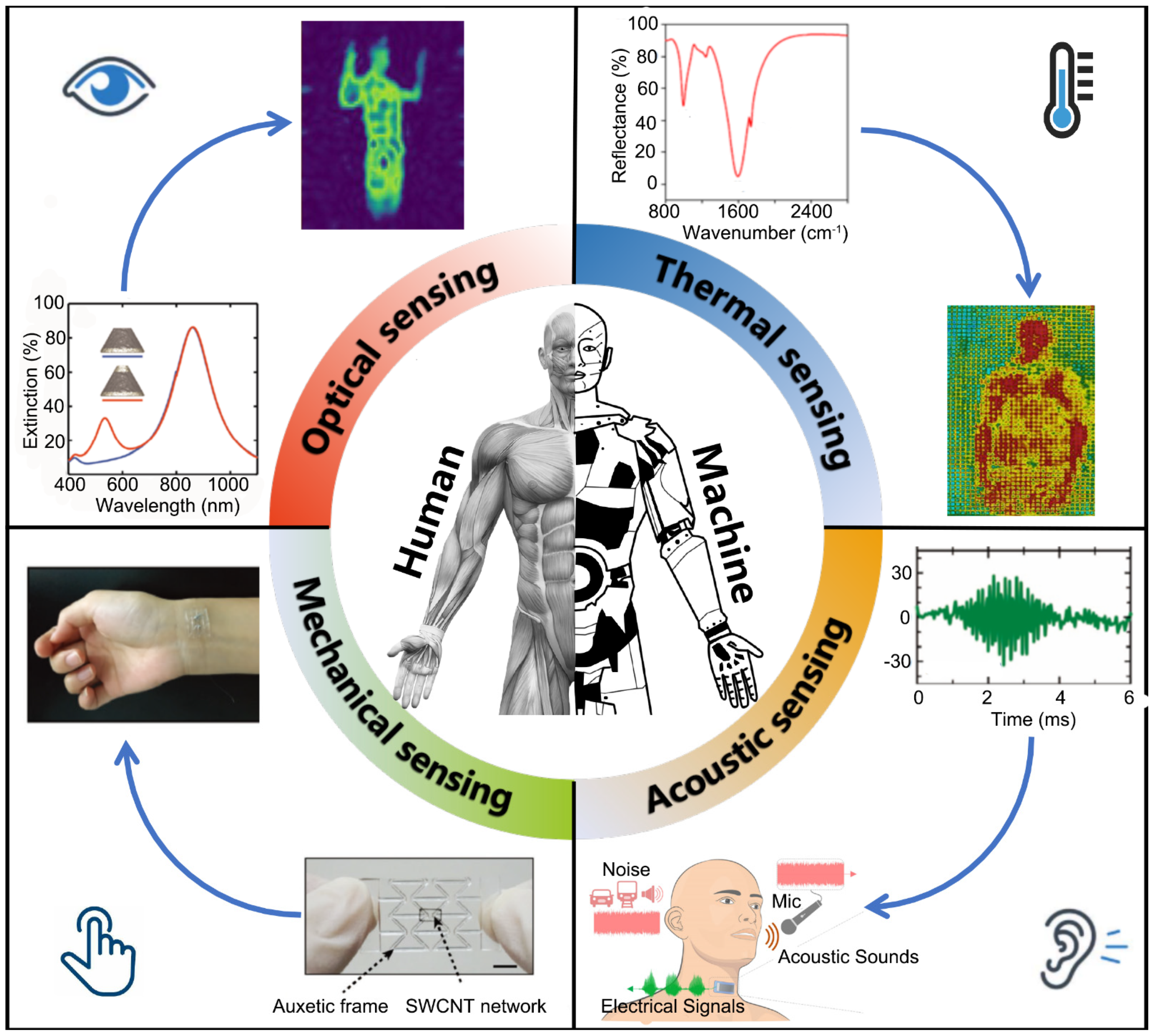
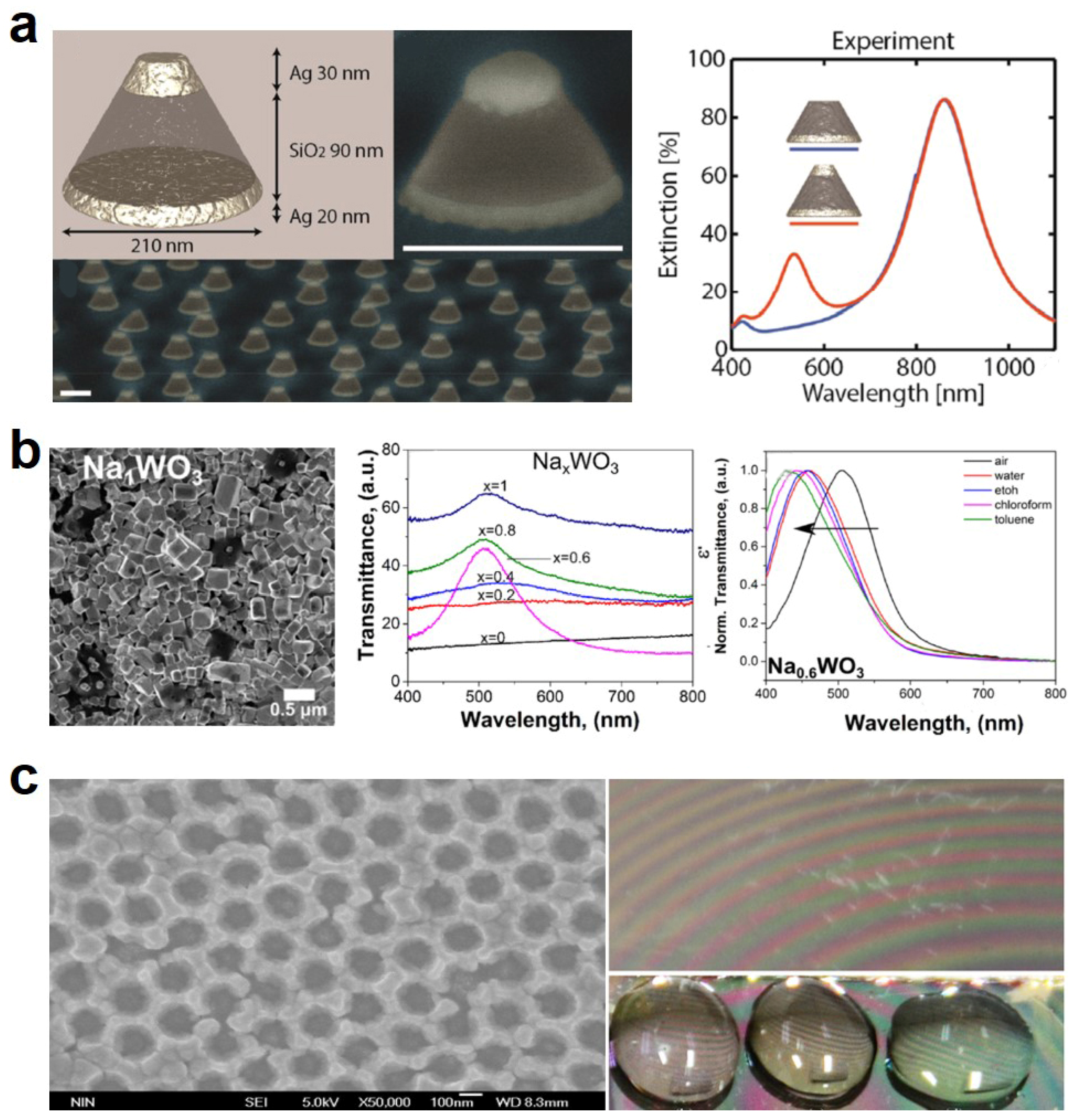
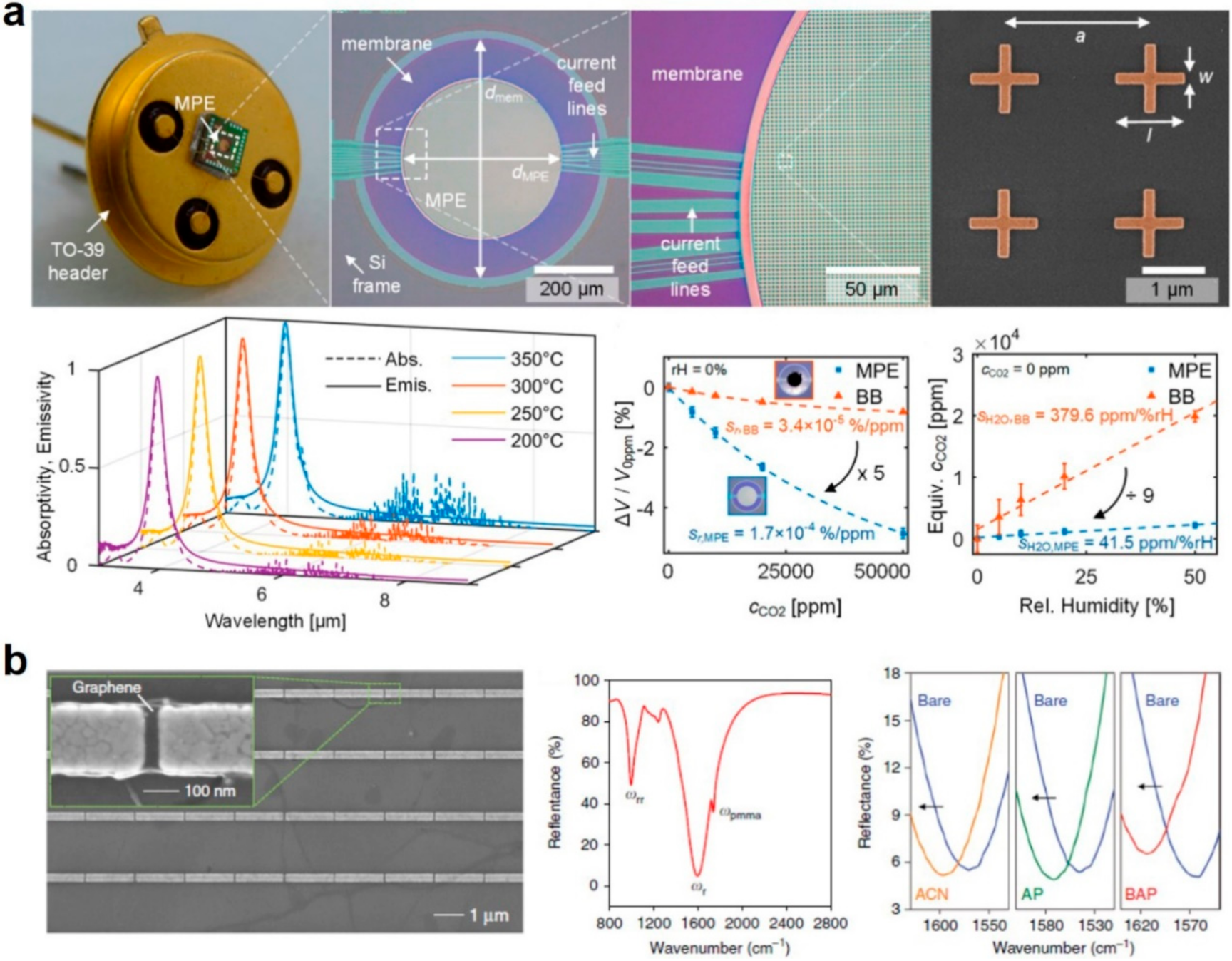
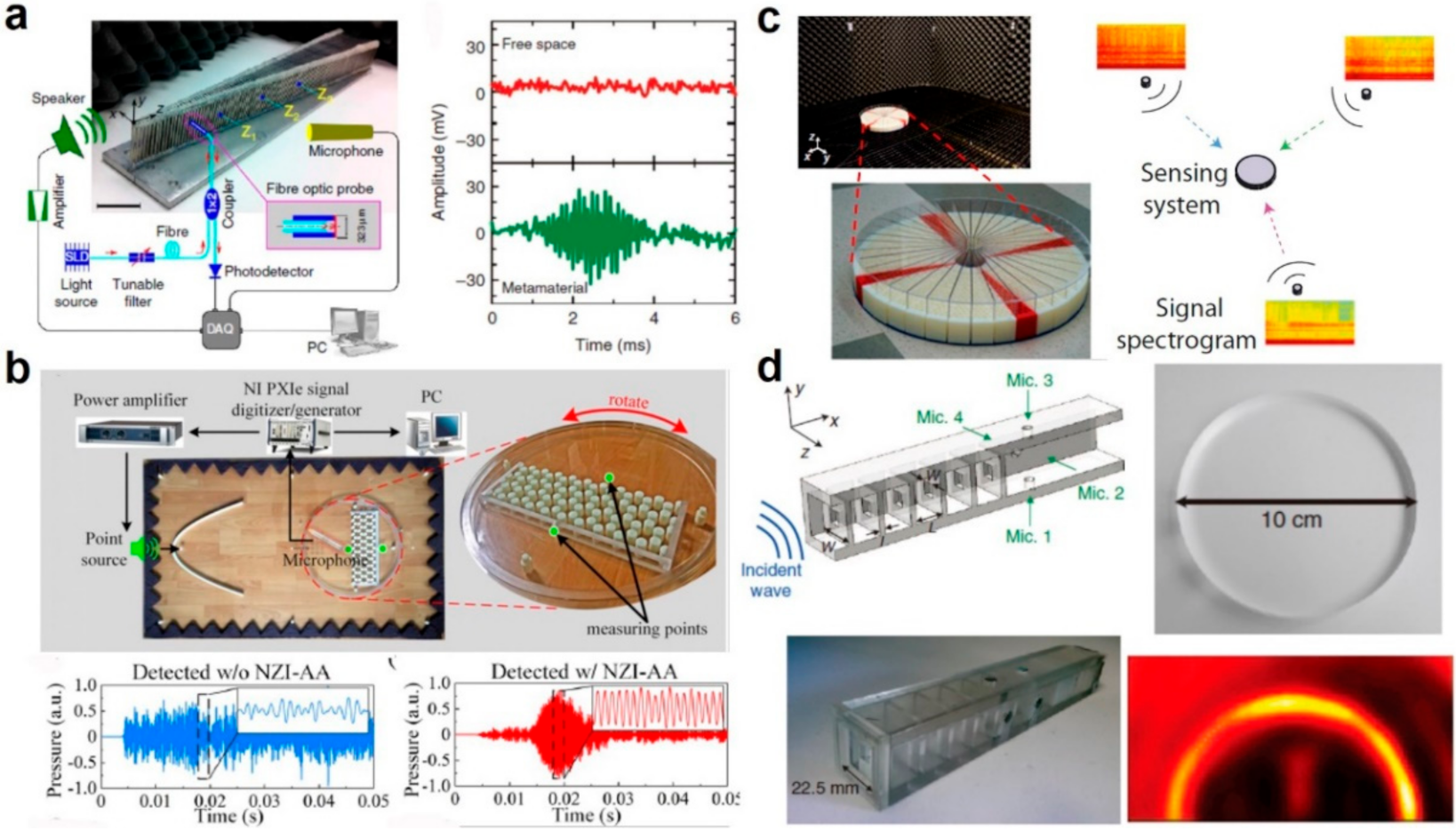

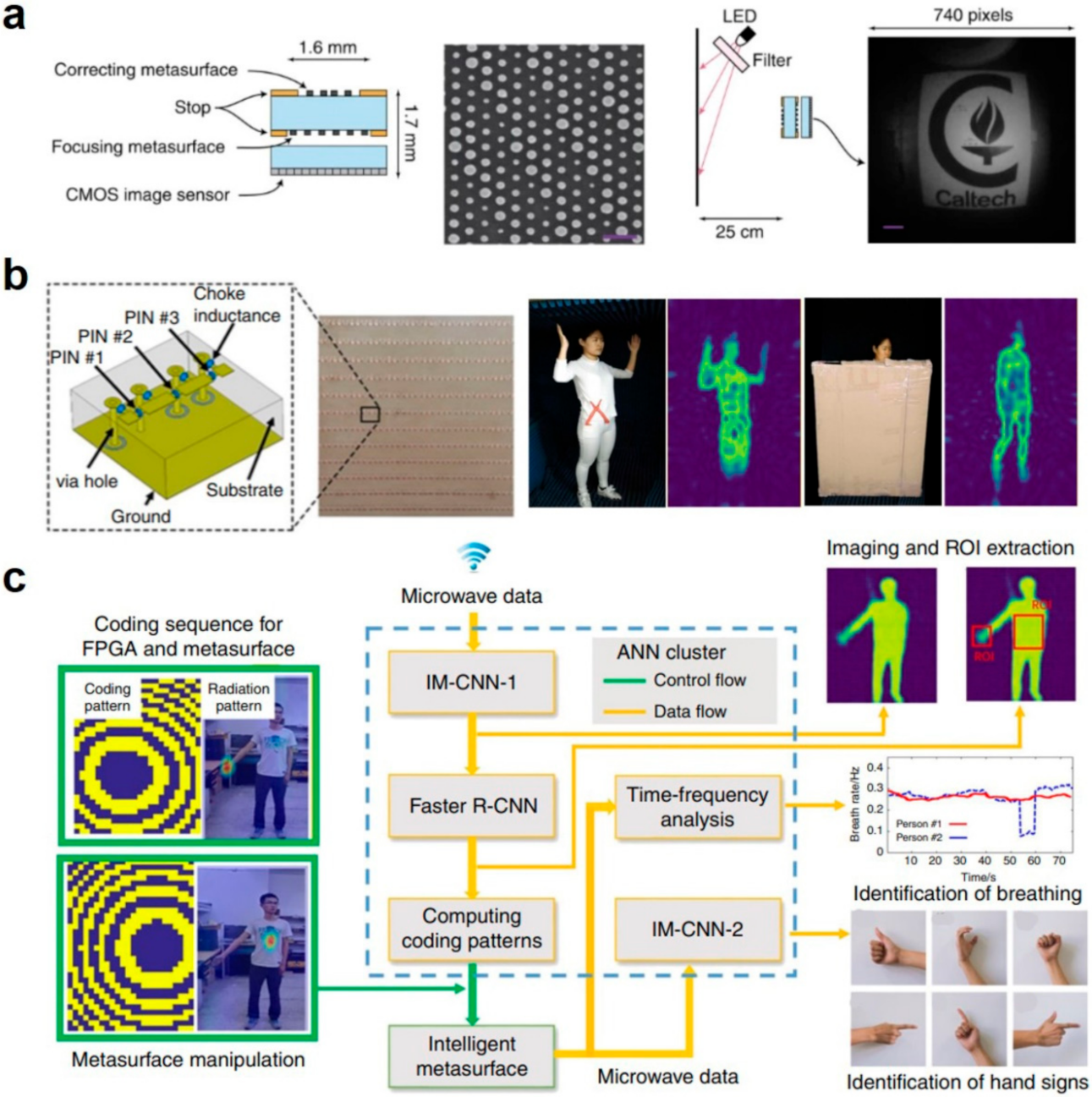
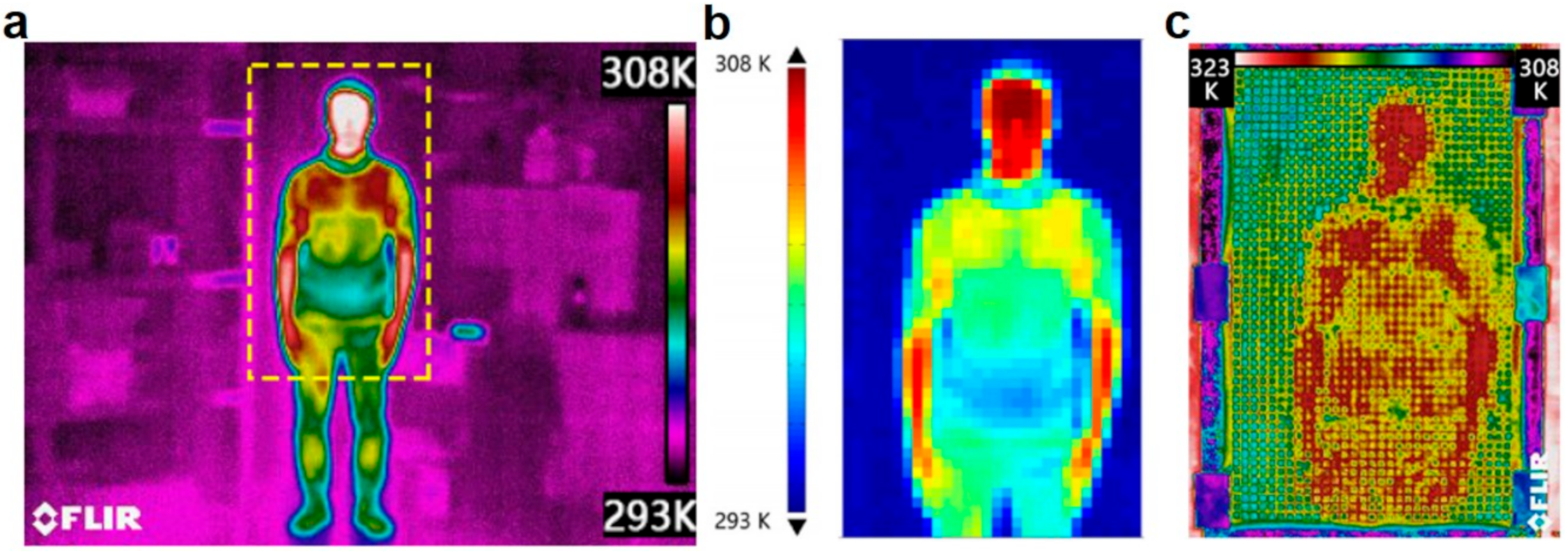
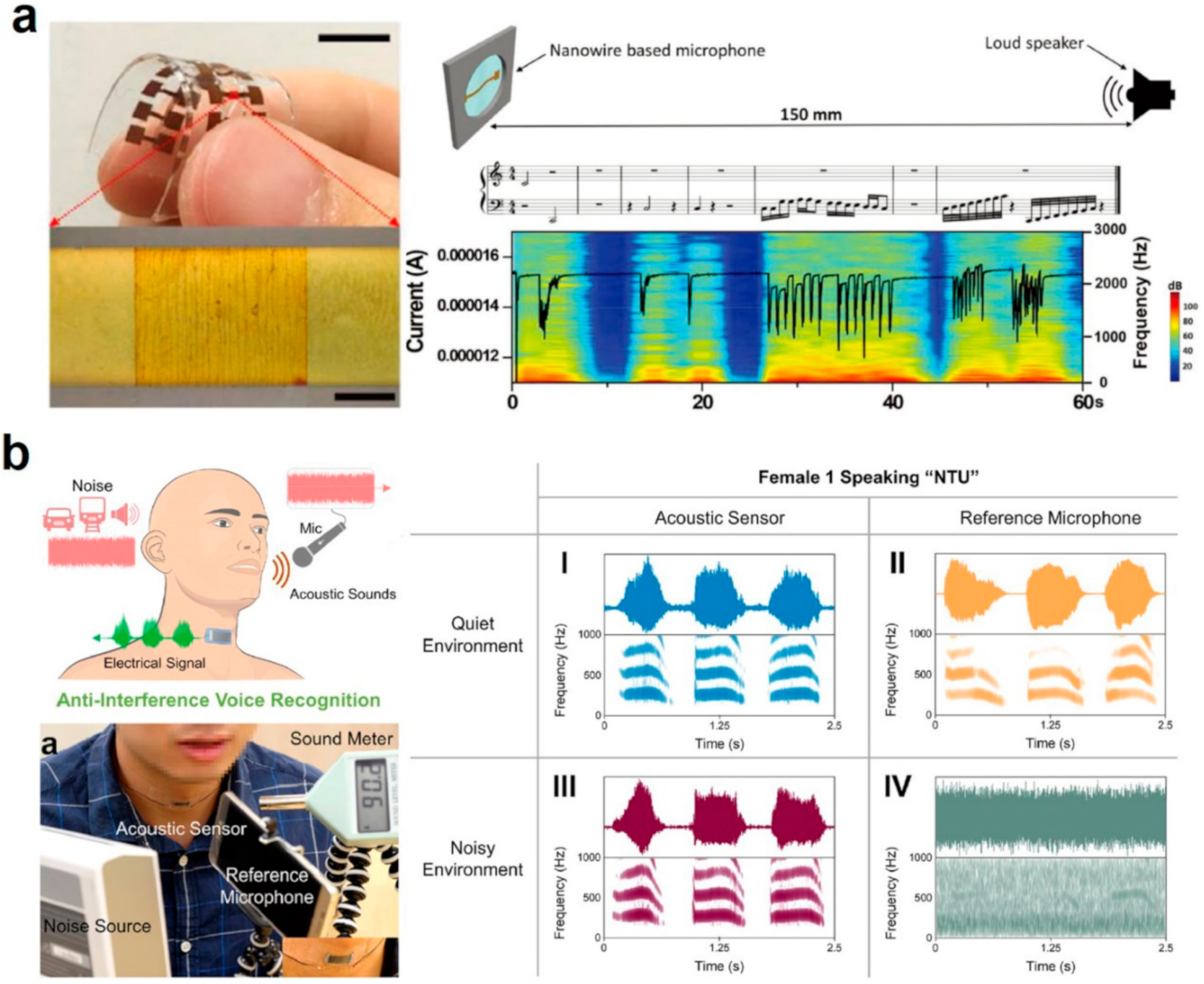
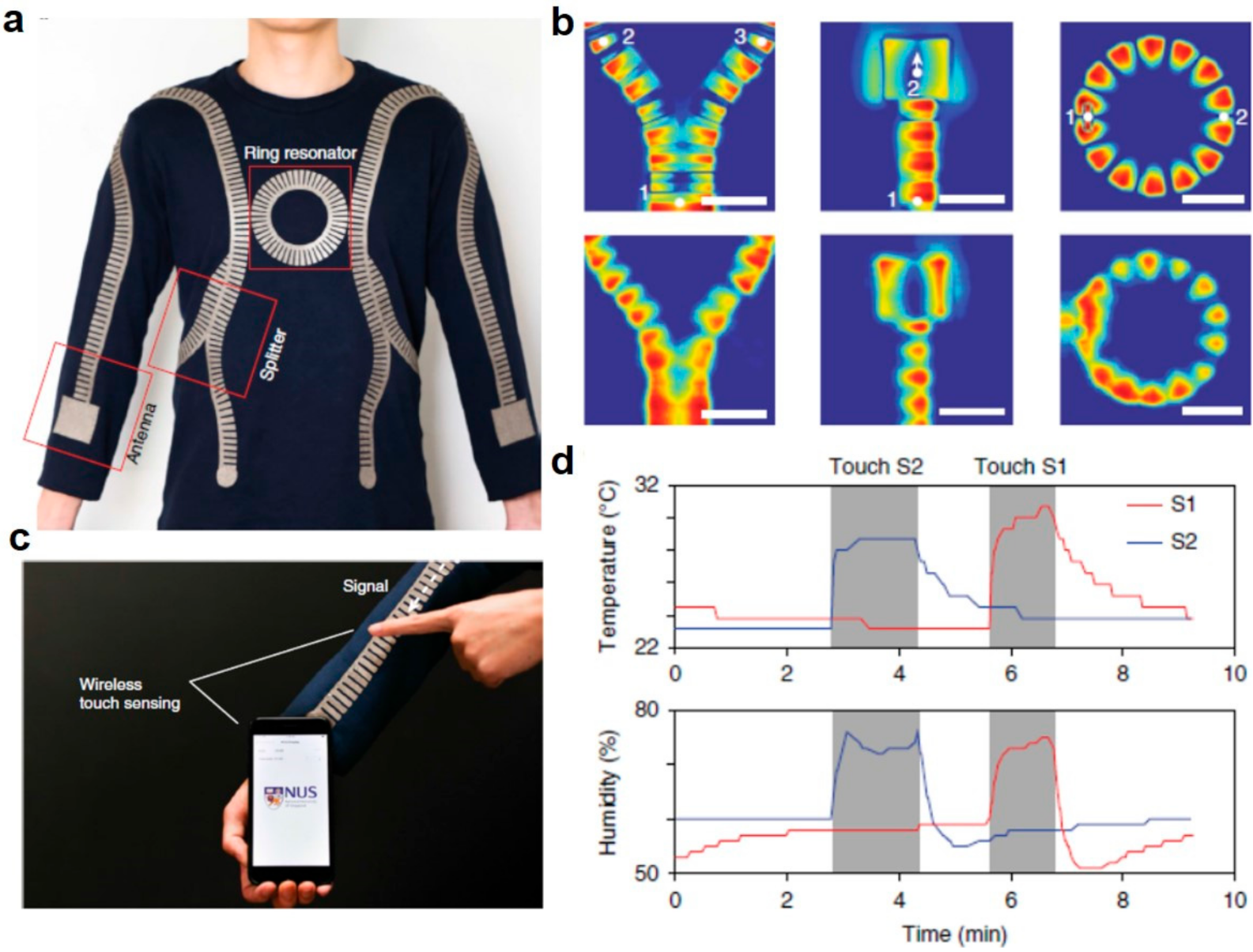
Publisher’s Note: MDPI stays neutral with regard to jurisdictional claims in published maps and institutional affiliations. |
© 2020 by the authors. Licensee MDPI, Basel, Switzerland. This article is an open access article distributed under the terms and conditions of the Creative Commons Attribution (CC BY) license (http://creativecommons.org/licenses/by/4.0/).
Share and Cite
Li, F.; Hu, R. Metamaterials-Enabled Sensing for Human-Machine Interfacing. Sensors 2021, 21, 161. https://doi.org/10.3390/s21010161
Li F, Hu R. Metamaterials-Enabled Sensing for Human-Machine Interfacing. Sensors. 2021; 21(1):161. https://doi.org/10.3390/s21010161
Chicago/Turabian StyleLi, Fei, and Run Hu. 2021. "Metamaterials-Enabled Sensing for Human-Machine Interfacing" Sensors 21, no. 1: 161. https://doi.org/10.3390/s21010161
APA StyleLi, F., & Hu, R. (2021). Metamaterials-Enabled Sensing for Human-Machine Interfacing. Sensors, 21(1), 161. https://doi.org/10.3390/s21010161




